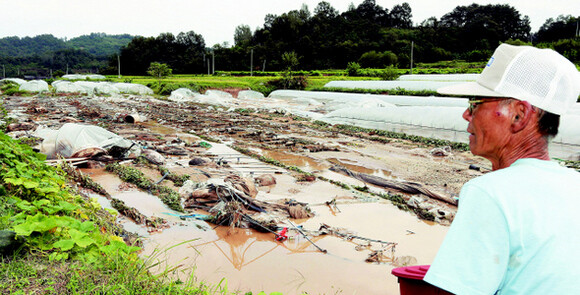hankyoreh
Links to other country sites 다른 나라 사이트 링크
2012 rice output lowest in 32 years

By Kwon Eun-jung, staff photographer
According to data released on Nov. 19 by the National Statistical Office (NSO), 2012 saw the lowest output of rice in South Korea in 32 years. The exceptionally low output is being attributed to a loss of agricultural areas and a series of typhoons that hit the country in late August.
The NSO found that 2012’s rice yield declined by 218,000 tons (5.2%) to 4.006 million tons, by the standard rate of a 92.9 percentage conversion from brown rice into white rice, year on year. The crop stands at the lowest since 1980, which saw a sharp drop in rice production due to unusually cold weather. If instead the percentage of converting brown rice into white rice is applied at 90.4 percent, a standard used in rice processing complexes, this year’s rice production stands at a mere 3.896 million tons.
In explaining the lower production, the NSO said that due to typhoons Bolaven and Tembin, which hit the Korean Peninsula at the end of August, at a key point in the rice growing process.
Major rice producers in South Jeolla, North Jeolla and South Chungcheong Provinces were then dealt the added blow of the “white head” phenomenon, in which rice panicles are not filled with grain. In addition, in September, typhoon Sanba stymied grain growth, the NSO said. This year’s rice production per 10 hectares stands at 473 kg, a 4.6 percent drop from 2011’s 496 kg.
849,000 hectares currently being used to grow rice is down 0.5% down from last year. The area planted with rice was steady between 1995 and 2002, before sinking to one million hectares (979,700 ha) in 2005, then to 900,000 in 2010 (892,000 ha).
By region, South Jeolla (700,000 tons) and North Jeolla (622,000 tons) provinces, which were hit the hardest by typhoons, witnessed the sharpest output drops of 15.5% and 9.1%, respectively. As a result, South Chungcheong province, which saw crops decline by 2.7% to 784,000 ton, took South Jeolla’s place as the country’s most productive rice-growing region.
Please direct questions or comments to [english@hani.co.kr]

Editorial・opinion
![[Column] Park Geun-hye déjà vu in Yoon Suk-yeol [Column] Park Geun-hye déjà vu in Yoon Suk-yeol](https://flexible.img.hani.co.kr/flexible/normal/500/300/imgdb/original/2024/0424/651713945113788.jpg) [Column] Park Geun-hye déjà vu in Yoon Suk-yeol
[Column] Park Geun-hye déjà vu in Yoon Suk-yeol![[Editorial] New weight of N. Korea’s nuclear threats makes dialogue all the more urgent [Editorial] New weight of N. Korea’s nuclear threats makes dialogue all the more urgent](https://flexible.img.hani.co.kr/flexible/normal/500/300/imgdb/original/2024/0424/7317139454662664.jpg) [Editorial] New weight of N. Korea’s nuclear threats makes dialogue all the more urgent
[Editorial] New weight of N. Korea’s nuclear threats makes dialogue all the more urgent- [Guest essay] The real reason Korea’s new right wants to dub Rhee a founding father
- [Column] ‘Choson’: Is it time we start referring to N. Korea in its own terms?
- [Editorial] Japan’s rewriting of history with Korea has gone too far
- [Column] The president’s questionable capacity for dialogue
- [Column] Are chaebol firms just pizza pies for families to divvy up as they please?
- [Column] Has Korea, too, crossed the Rubicon on China?
- [Correspondent’s column] In Japan’s alliance with US, echoes of its past alliances with UK
- [Editorial] Does Yoon think the Korean public is wrong?
Most viewed articles
- 1[Column] Park Geun-hye déjà vu in Yoon Suk-yeol
- 2Thursday to mark start of resignations by senior doctors amid standoff with government
- 3N. Korean hackers breached 10 defense contractors in South for months, police say
- 4[Editorial] New weight of N. Korea’s nuclear threats makes dialogue all the more urgent
- 5Will NewJeans end up collateral damage in internal feud at K-pop juggernaut Hybe?
- 6Kim Jong-un expressed ‘satisfaction’ with nuclear counterstrike drill directed at South
- 7[Editorial] Japan’s rewriting of history with Korea has gone too far
- 8[Column] ‘Choson’: Is it time we start referring to N. Korea in its own terms?
- 9[Cine feature] A new shift in the Korean film investment and distribution market
- 10[Column] The clock is ticking for Korea’s first lady